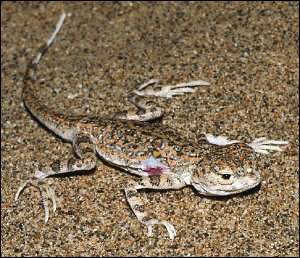 James Cornett
James Cornett Special to The Desert Sun
Coachella Valley residents are well aware that sand dunes cover only a small portion of the desert. On my recent trip to China's Gobi Desert, however, all the Chinese with whom I spoke considered desert to be synonymous with sand dunes. Ask a Chinese driver to take you to the desert, and he will drive you to the nearest dunes.
There are many sand dune complexes scattered across the Gobi. One of the most impressive is located immediately south of Dun Huang, a desert city of about 150,000 inhabitants. The dune system here is nearly 50 miles wide with piles of sand reaching 500 feet in height. The golden dunes provide a spectacular backdrop to the city. It's not surprising that visiting the dunes and riding Bactrian or "two-humped" camels to the top is one of the town's chief Chinese tourist attractions.
It was on my first afternoon on the dunes that I encountered a lizard. It scurried away from the camels on which my guide and I were riding. I told him that I wanted to dismount quickly so that I might chase and capture the fast-moving reptile - easier said than done. Dismounting a camel does not happen rapidly as it is an awkward series of movements for the camel, particularly when carrying a human with absolutely no experience as a camel jockey. But my guide finally got the protesting animal down and I was off across the dunes on foot.
The lizard dodged all of my awkward lunges, much to the amusement of the guide. Finally taking pity on my efforts, he hopped off his camel and joined me in the pursuit. No doubt we resembled old-time "Keystone Cops" as we scampered about the dunes desperately trying to corral the agile reptile. I had the last laugh when the lizard shoved itself into sand head first and quickly disappeared.
I suspected the lizard might use this escape tactic. It was the same behavior practiced by our own Coachella Valley fringed-toed lizard, now an officially threatened species. I had seen the exact spot where my Gobi Desert lizard had entered the sand and never took my eye off it.
The guide was confused and had no idea where the lizard had gone. This was not surprising. Never before had a foreigner expressed an interest in, of all things, a lizard. He saw these "sand" lizards every day but had never tried to capture one. "The lizard become the sand," he said to me. I assumed he meant that the lizard's color and pattern enabled it to blend in perfectly with the sand substrate on which it lived. It was so well camouflaged that it had to move before it could be seen.
I shoved my hand into the sand and to his amazement pulled out a wiggling four-inch reptile. It was an agamid lizard, a member of a large family of Old World lizards found from Africa through Asia. I recognized it from its roundish head and relatively narrow neck. I had no idea what species of agamid it was. I would not be surprised if no one else did, either. Naming, classifying and mapping the ranges of all the plant animal species in China is a daunting task involving large sums of money and technical personnel. Considering that China, with its 1.3 billion inhabitants, is the most populated nation on Earth, I strongly suspect the government has higher priorities.
As my guide and I examined the lizard, I noticed some strange protrusions from the toes on its hind feet. They were elongated scales that looked like fringes. This agamid lizard had developed enlarged scales on its hind toes to increase its traction on sand, just like our own Coachella Valley fringe-toed lizard, the one on the other side of the planet.

No comments:
Post a Comment